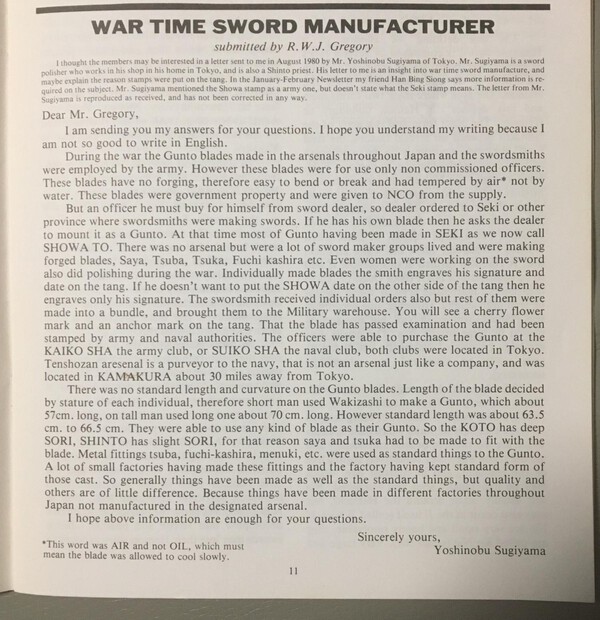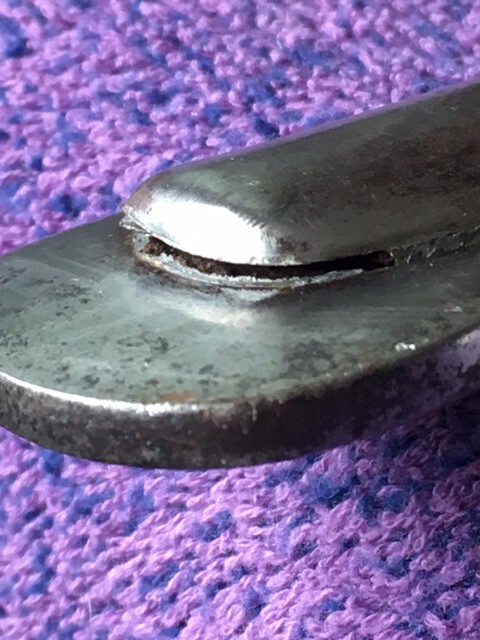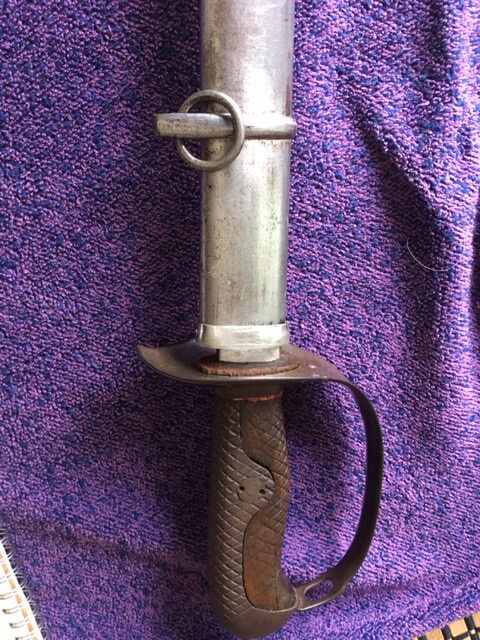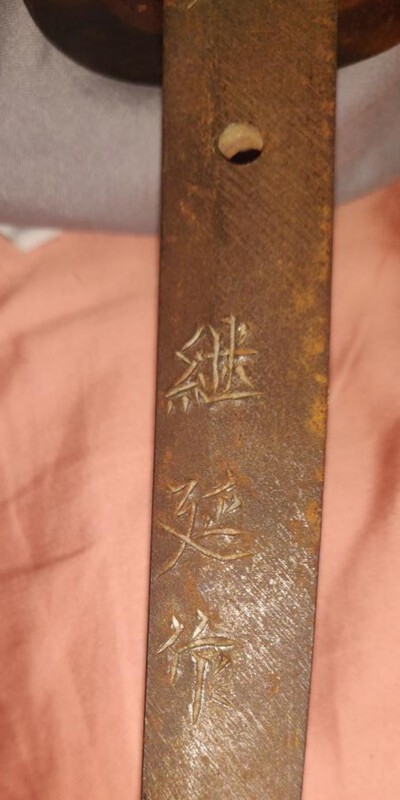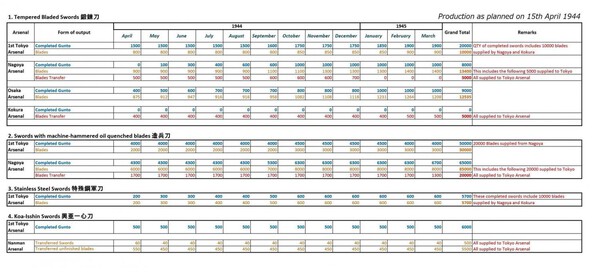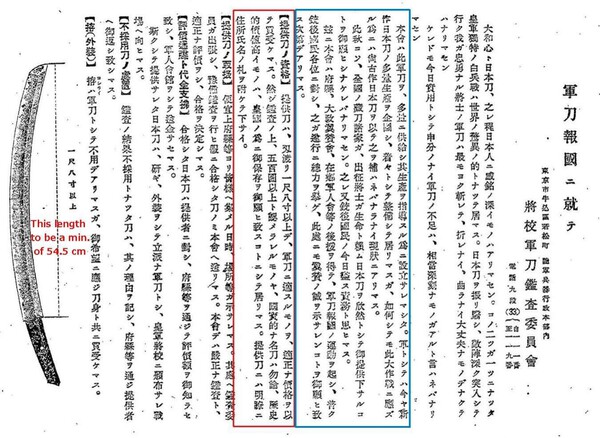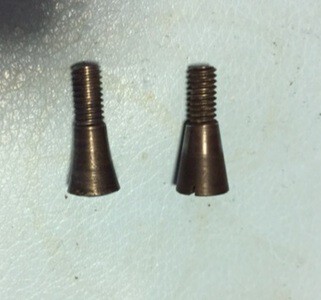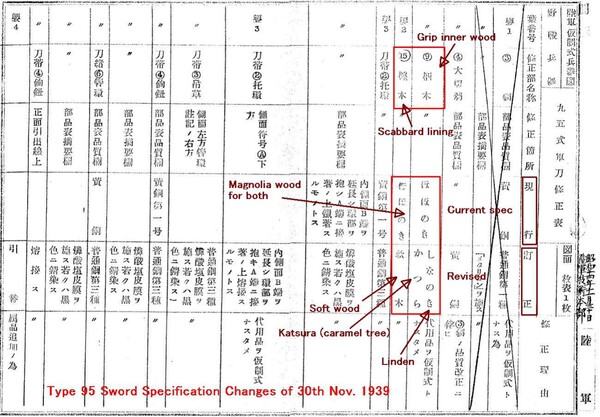-
Posts
13,048 -
Joined
-
Last visited
-
Days Won
155
Content Type
Profiles
Forums
Events
Store
Downloads
Gallery
Everything posted by Bruce Pennington
-

Attention Mantetsu Owners: A Survey
Bruce Pennington replied to Bruce Pennington's topic in Military Swords of Japan
I think you nailed it JP. Neil (IJASWORDS) just dug out an article from JSSUS that included a letter from a WWII era polisher to Robert Gregory. In it, he says swords were bundled and sent to an Army warehouse in Tokyo and distributed to the Army and Navy clubs for sale! A couple of other points from the letter: 1. NCO blades were "air" cooled, not water or oil 2. Custom orders were made to fit the height of the buyer, and wakizashi were used along with every other length -

Verification of Japanese Sword Kyu gunto type 19
Bruce Pennington replied to AjschulerA's topic in Military Swords of Japan
Thanks mate! Didn't know they could move, but I've only had 2 in-hand and have never studied them. Now that you mention it, one of my Type 32s, an Otsu, is in a Type 19 saya that too short. Some Bubba actually shoved the blade into the saya so hard, the tip split the end of the saya. -
-

Verification of Japanese Sword Kyu gunto type 19
Bruce Pennington replied to AjschulerA's topic in Military Swords of Japan
Hamish, Forgive my inexperience, but isn't the ashi too close to the saya throat? -

Attention Mantetsu Owners: A Survey
Bruce Pennington replied to Bruce Pennington's topic in Military Swords of Japan
Nick Komiya, Warrelics, made a full translation of the 1944 sword production chart we saw earlier. Points of interest: 1. It confirms what we've always heard that Kokura wasn't making/finishing blades, simply inspecting and tranfering them. 2. In the Koa Isshin block at the bottom, it lists "Nanman" not SMR or Mantetsu. The 50-60 finished blades per month is evidence that Nanman was at least finishing Mantetsu blades (Koa Isshin blades!). But as the supervisory arsenal over SMR, this list could simply be listing the Koa's supplied to them BY SMR and transfered (like Kokura). But, the rest of the chart shows the arsenals were making blades (except Kokura). Using that same standard, this chart must be showing than Nanman was making them too (50-60). 3. I find the Osaka block interesting. I had read that the Osaka arsenal was producing blades, but other than the rare "Saka" stamped blades, we almost never see them. Yet, they were making more blades that Mantetsu. I wonder why the large number of blades were transfered to Tokyo? It might depend on where the new officer graduates were processed, or where the most clubs/shops were located for sale to officers? -
The nakago alone screams "Not Japanese!!!". Having said that, it's not bad enough to be an island sword, in fact most legit island swords don't try to BE a Japanese sword, they just have flavors of Japanese military in them. Fakes try to BE Japanese swords. So in that sense, this leans toward fakery. The kabutogane and fuchi (photos too dark, could use bright, clear pics of them) look right. The tsuba from a distance looks good, but up close, it has the sand-blasted look of fakes and the petal tips of the sakura, instead of being formed as cherry, were formed like plum, but then the craftsman used a small chisel to split the tips. The rust on the blade (from the photos) looks like chromed steel looks when it corrodes. Might be the photo. There were some hacks in the business during WWII, that's why the military had inspectors, but how many of them actually got gunto into the field is unknown. But I'd lean toward fakery on this.
-

Wooden Insert For Nco Gunto Scabbard
Bruce Pennington replied to BANGBANGSAN's topic in Military Swords of Japan
That's pretty cool, Rob! You're going to hear a big "AHHhhhhhhh" from your blade when you slide it into those new digs! If I ever come by some more hobby money, I'll have to send you my saya with one half of the liner missing, for a replacement! -
While my data-base is still small, it is interesting to note the practice of dating the blades seemed to have increased over time, if these stamped blades are any indicator. Showa 1940,1940,1941, and 15 blades w/o dates Seki 1941, three 1942, three 1944, two 1945, 5 blades w/o dates Seki/Gifu 1944, 1945 Gifu two 1943, 1944, two 1945 Saka (added to survey) 1945 Admittedly, many of the blades without dates are from my search through the threads to gather data, and the posts they came from simply didn't show or discuss dates. So, many of them may in fact have been dated. but we know the Army Sword Department took authority over all sword production in 1942 (maybe late 1941). This might explain the increase in observed dates on blades. Could it be that the Army required the dates on blades? Yet another unknown.
-

Whats the Value of this sword group?
Bruce Pennington replied to WW2UsCollector's topic in Military Swords of Japan
Colin, The condition of the paint on the saya (scabbard) does not detract from the value. Most Type 95s on the market are in "used" condition. You can come across some that have "mint" paint jobs, including the tsuka (handle), and the seller ususally asks for more in that case. But yours is in average condition, and worth the price I listed. You can read about the meaning of the stamps on the copper collar (fuchi) here: http://ohmura-study.net/794.html -
George, this was an Army program to buy swords. Here's what Nick said about the flyer, and a pertenant section of his post about buying: "The flyer is titled "About serving your nation with Guntos" and would have been delivered in the newspapers or passed around as a neighborhood round robin. The leaflet is not dated, but it can be told from the name of the issuing authority that it was issued after February 1942." and "The 1942 program that relates to that leaflet is strictly an army program, managed under the Chief of Army Weapons HQ and evolved from the earlier 1938 program which was indeed a army/navy joint program. This appraisal organization was established on 19th February by Army Regular Ordinance 990. It was a program supported by the local Veterans Association as well as the Taiseiyokusankai Political Party. Municipalities would announce the dates and venues of the appraisal sessions and the army sent its appraisers to do preliminary screening. Only the swords that passed this screening were sent further to the HQ of the Officer Gunto Appraisal Committee 将校軍刀監査委員会 for a full screening to determine a fair price. Owners of swords that passed got a notice of appraised value through their local municipal office and the money was remitted by the Gunjinkaikan. Those swords were polished and set into proper new Koshirae and sold to Army officers. Yes, the maximum blade quality for this program was 500 Yen, which meant that they would sell at much higher prices than the Rinjiseishiki specials. If there were swords that got dropped in the second appraisal, they got returned to owners with detailed explanations as to why. The program only required the blades, but owners who wished to sell the swords complete with Koshirae was paid for the Koshirae as well. I just checked the original army/navy joint buy-up program rules announced in the fall of 1938 and discovered that the blade length criteria of minimum 54.5 cm was already in effect from that time. The 1942 rules are more streamlined and easier for the public to follow and contribute, but otherwise it is the same program, just without the involvement of the navy." Quotes from this discussion: http://www.warrelics.eu/forum/Japanese-militaria/family-short-blades-gunto-688110/
-

Whats the Value of this sword group?
Bruce Pennington replied to WW2UsCollector's topic in Military Swords of Japan
Colin, Welcome! I can't speak to the flag, but the sword is a Type 95 NCO gunto. The blade is in really nice shape and the serial numbers match. COVID has really messed with market prices, so for now, the NCO's are selling from $750-1,000. I'd put yours toward the higher end of the range. -
Mark, This model had no official title. Designed in 1938, it began production in 1940, yet almost all the one's we've seen today are '43-'45. It was enacted under a "other" category and called a Contingency sword (Rinji-seishiki). Big discussion about them here: http://www.warrelics.eu/forum/Japanese-militaria/deflating-another-myth-type-3-army-officera-s-sword-expanded-version-584796/
-
Astonishing collection. The articles are great too.
-

Star Stamped Tsutsui Kiyokane Blade
Bruce Pennington replied to cisco-san's topic in Military Swords of Japan
Sorry Chuck, I knew I was going to cause confusion when I chose those words! The screw goes in the ana closest to the tsuba. Mekugi is closest to the kabutogane. -

Star Stamped Tsutsui Kiyokane Blade
Bruce Pennington replied to cisco-san's topic in Military Swords of Japan
Ok, this is what you are seeing in my Rinji. It's an original WWII screw made for the Rinji tsuka. Mine was missing the screw, and I got one from Neil. The Bubba-bolt was on another Rinji. -

Star Stamped Tsutsui Kiyokane Blade
Bruce Pennington replied to cisco-san's topic in Military Swords of Japan
I've tried, and tried, but I can't figure out the joke, Dave. I know a snipe hunt is a joke guys play on rookies, but I'm lost with the reference, here. -

Wet, dirty Saya Liners
Bruce Pennington replied to Bruce Pennington's topic in Military Swords of Japan
While reading some of Nick's posts on the Type 95, I came across this: "Back in November 1939, because of the China Incident, they had to set up B-spec materials for making the swords and at that time the scabbard liner and grip inner wood material specs were expanded to include other species. Before, only magnolia was accepted, but Katsura (Caramel Tree) and Japanese Linden (Tilia japonica) were added as acceptable substitutes at that time. Shown below is the full spreadsheet for those changes which I omitted earlier, when I touched upon the changes briefly." found here: http://www.warrelics.eu/forum/Japanese-militaria/short-development-history-type-95-gunto-676112-3/ -
All you Nihonto pro's forgive me, but I see a suguha running underneath the artificial hamon. But I could be totally out-to-lunch!
-
Thanks Kiipu! I understand now. Back then, I simply thought you were saying the blade required a special inspector's approval. I had no idea the kanji litterally meant "special". It reminds me of the early years when I read Ohmura's description of Mantetsu serial numbers using the iroha system. I didn't know what he meant, so it went right by me. I've updated the Stamps Doc to reflect this, thank you!
-

The Mysterious "w" Stamp!
Bruce Pennington replied to Bruce Pennington's topic in Military Swords of Japan
Thanks John! I know that Mantetsu wasn't the only blade producer that used the zodiacal dating system, but I just had to check on yours! It is an unusual place for the koshirae fitters to put a number. I've saved it for my records. Thanks again!


